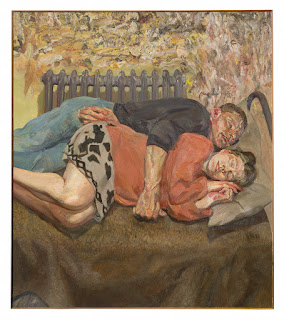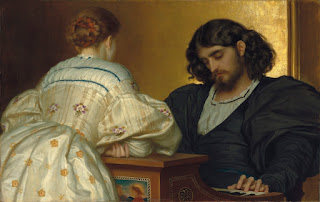London - An intimate family portrait by Lucian Freud painted in 1992 (below); a pivotal example from 1864 of British Aestheticism at auction for the first time in 100 years by Frederic, Lord Leighton (below); and from 1778, an exquisite portrait by Sir Joshua Reynolds on the market for the first time (below), are among the great works of British art to be offered in a sale alongside an exhibition which will launch Christie's 250th anniversary in London this June. Building on the success of Christie's pioneering series of curated Evening Sales to date, including Looking Forward to the Past and The Artist's Muse in 2015, Christie's will celebrate the artistic legacy of four centuries of British artists, with Defining British Art: Evening Sale (30 June) and Defining British Art: Loan Exhibition (17 June to 15 July). These Evening Sale highlights, a trio of exceptional figurative paintings which come from major private collections and illustrate the evolving face and social customs of British portraiture over three centuries, are among the works that will tour to Christie's New York: 6 to 12 May and Christie's Hong Kong: 26 May to 30 May.
Ever since James Christie first opened his doors for business in 1766, in St James’s London, where the headquarters remain today, Christie’s has championed British art and artists, with both Reynolds and Gainsborough among the regular visitors to Christie’s salerooms. The greatest masterpieces are those that define the artist; paintings and sculpture that reflect the quintessential nature of that artist’s lasting legacy. Christie’s Loan Exhibition and Evening Sale will present works which exemplify this.
Orlando Rock, Chairman, Christie's UK: ' A celebration of Britain's artistic achievement, the Defining British Art Loan Exhibition and Evening Sale will break new ground for Christie's, charting the evolution of British art over the last 400 years. A fitting launch to Christie's 250th Anniversary celebrations in London and inspired by James Christie's own innovative spirit, the sale and exhibition will create dynamic juxtapositions and, we hope, inspire artists and collectors of the future. Open to all, I would like to encourage not only those who are already friends of Christie's but also those we have yet to welcome, to share in these celebrations and become part of our next chapter, looking ahead to the next 250 years and beyond.
Jussi Pylkkänen, Global President of Christie’s International: “On the night of 30 June here in London we will hold a landmark sale of major paintings and sculpture to celebrate our 250th year. The auction will be the first sale of its kind to span four centuries of great British painting from Sir Joshua Reynolds to Frederic, Lord Leighton and Lucian Freud. Our specialists from across the globe have worked together to curate what promises to be a fascinating overview of British Art.”
 |
LUCIAN FREUD (1922–2011)
Ib and her husband
oil on canvas
66 ¼ x 57 ¾ in. (168.3 x 146.7 cm.)
Painted in 1992
Estimate on request (in the region of £18 million)
|
Lucian Freud Ib and Her Husband, 1992, is a scene of family affection: (Estimate on Request: in the region of £18 million). The tender brushstrokes that describe the entwined figures of Freud’s daughter Ib (Isobel Boyt) embraced by her partner Pat Costelloe, give a glimpse into the world of the artist’s family at a moment of extreme intimacy: Ib’s pregnancy. Freud’s paintings of his daughters trace an ever-growing tenderness between father and child that was only forged later in life, since Freud had been absent for much of Ib’s childhood. This painting has been exhibited in Freud’s major retrospective, ‘Lucian Freud: Recent Work’ (1993-4) which took place in London, The Whitechapel Art Gallery; New York, Metropolitan Museum of Art and Madrid, Museo Nacional Centro de Arte Reina Sofía.
 |
Frederic, Lord Leighton, P.R.A. (1830-1896)
Golden Hours
oil on canvas
31 1/2 x 49 in. (80 x 124.5 cm.)
Painted in 1864
Estimate: £3,000,000-5,000,000
|
At auction for the first time in 100 years, Golden Hours, 1864, by Frederic, Lord Leighton (1830–1896) is a celebration of youth, beauty, and love, three universal elements which transcend time and geographies (estimate: £3-5 million). Transporting the viewer to 16th century Venice and the world of Giorgione, this work is recognised as a pivotal masterpiece of British Aestheticism, allowing the viewer to revel in the seductive atmosphere, and to dream. With most major works by Leighton in museum collections, this is one of the last remaining examples in private hands. Last seen in public 20 years ago, it was exhibited in the Leighton retrospective at the Royal Academy of Arts in 1996.
 |
Sir Joshua Reynolds, P.R.A. (1723-1792)
Portrait of Lucy Long, Mrs George Hardinge (d. 1820), daughter and heiress of Richard Long of Hinxton, Cambridgeshire, in a white dress with a sheer brown scarf and a ribbon and pearls in her hair, with her spaniel, in a landscape
oil on canvas
50 1/8 x 40 1/4 in. (127.3 x 102.1 cm.)
Painted in 1778
Estimate: £2,000,000 - £3,000,000
|
Never previously offered for sale, Sir Joshua Reynolds, P.R.A. Portrait of Lucy Long, Mrs George Hardinge - a society beauty - is one of the finest works by the artist to come to the market in a generation (estimate: £2-3 million). Preserved in remarkable condition, this is a prime example of the work of the first President of the Royal Academy, who was a close friend and advisor to James Christie. Offered from the collections at Harewood House, Yorkshire, it was originally painted for Georgina, Lady Peachey in 1778, two years after Christie’s was founded. A prime date for the artist, it has passed by direct descent through the Marquess’ of Clanricarde to the present day. Last included in a public exhibition at the Royal Academy in 1934, this painting has not been seen outside of Harewood for over 80 years.
Further details about Evening Sale highlights will be available in May.
The Loan Exhibition will present many outstanding British art works that have been handled by Christie’s in the last 250 years, including examples by leading artists working in Britain (open free to the public from 17 June to 15 July).
#trinitycollections
👉 Like. Share. Subscribe to our Post as a support to our labour of love - sharing art.
Photos: by Christie's






